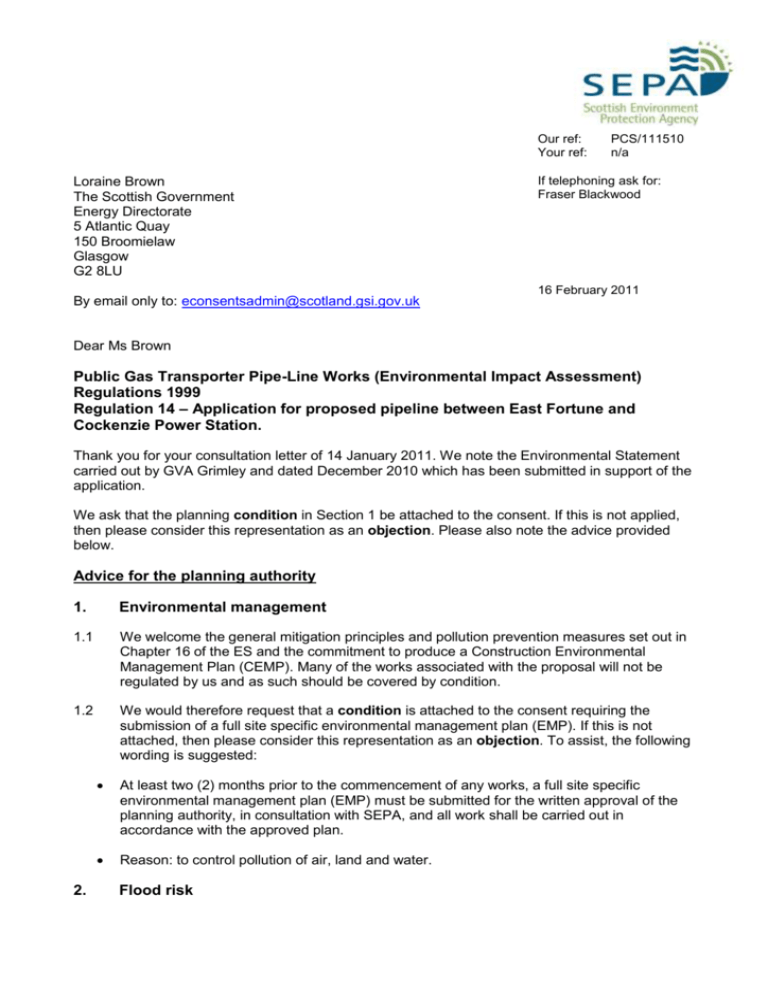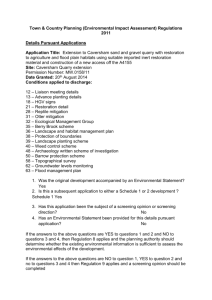2. Flood risk - The Scottish Government
advertisement

Our ref: Your ref: Loraine Brown The Scottish Government Energy Directorate 5 Atlantic Quay 150 Broomielaw Glasgow G2 8LU By email only to: econsentsadmin@scotland.gsi.gov.uk PCS/111510 n/a If telephoning ask for: Fraser Blackwood 16 February 2011 Dear Ms Brown Public Gas Transporter Pipe-Line Works (Environmental Impact Assessment) Regulations 1999 Regulation 14 – Application for proposed pipeline between East Fortune and Cockenzie Power Station. Thank you for your consultation letter of 14 January 2011. We note the Environmental Statement carried out by GVA Grimley and dated December 2010 which has been submitted in support of the application. We ask that the planning condition in Section 1 be attached to the consent. If this is not applied, then please consider this representation as an objection. Please also note the advice provided below. Advice for the planning authority 1. Environmental management 1.1 We welcome the general mitigation principles and pollution prevention measures set out in Chapter 16 of the ES and the commitment to produce a Construction Environmental Management Plan (CEMP). Many of the works associated with the proposal will not be regulated by us and as such should be covered by condition. 1.2 We would therefore request that a condition is attached to the consent requiring the submission of a full site specific environmental management plan (EMP). If this is not attached, then please consider this representation as an objection. To assist, the following wording is suggested: 2. At least two (2) months prior to the commencement of any works, a full site specific environmental management plan (EMP) must be submitted for the written approval of the planning authority, in consultation with SEPA, and all work shall be carried out in accordance with the approved plan. Reason: to control pollution of air, land and water. Flood risk 2.1 We have no objection to the proposed development on flood risk grounds. However, we would strongly recommend that appropriate mitigation measures are put in place to ensure that there is no loss of floodplain storage volume or reduction in conveyance capacity as a result of the development. 2.2 We would therefore strongly advise that flood risk impacts should be added to the ‘Potential Effects’ in Table 16.1 of the ES and appropriate mitigation measures be outlined within the finalised EMP. Further advice and recommendations are outlined in Appendix 1. In summary however, mitigation measures should include: Restoring floodplains to existing levels and channels to existing conveyance capacities. Restoring drainage ditches and field drains. Mitigating the risk of creating new preferential pathways for intercepted groundwater. 2.3 Notwithstanding this, we would expect East Lothian Council to undertake their responsibilities as the Flood Prevention Authority. 2.4 As we understand, a detailed assessment of groundwater is still to be undertaken and SEPA would welcome the opportunity to provide additional comment when the results of this assessment become available. 3. Groundwater 3.1 We note from Section 11.5.1.1 of the ES that in terms of groundwater abstractions, a ‘permit to pump’ system will be operated on site. We would generally have no objection to dewatering an excavation at a construction site, provided the proposed works are in compliance with General Binding Rules (GBRs) 2 and 15 of the The Water Environment (Controlled Activities) (Scotland) Regulations (CAR) 2005. Any abstraction of groundwater in greater quantities or for longer durations than those outlined under GBRs 2 and 15 will require a registration or licence. 3.2 Section 11.3.2 of the ES states that Ordnance Survey 1:25000 topographic mapping has identified six wells and two springs located within the pipeline corridor. If dewatering works are required, we would recommend that SEPA and the Local Authority are consulted to determine if any existing licensed abstractions or private water supplies lie along the route of the pipeline. It should be noted that GBR 15 prohibits abstractions from any wells, boreholes or excavations within 250m of existing abstractions. 3.3 To date, we have received no application for abstraction authorisation under CAR. Based on the information provided at this stage, we are satisfied in principle that any required abstraction works are capable of authorisation under CAR. 3.4 It is proposed that exposed ground and soil stockpiles will be managed to minimise their erosion and the generation of silt laden run-off. Fuel/oil spillages have also been noted as a potential source of contamination and the mitigation methods proposed are considered acceptable. 4. Watercourse engineering works 4.1 We note that the preferred method for pipeline crossings over watercourses appears to be the isolated open cut method. Such works will require authorisation from us under the Water Environment (Controlled Activities) (Scotland) Regulations 2005 (as amended) (CAR). 4.2 To date, we have received no application for authorisation for engineering works under CAR. However, we are satisfied that in principle, the proposed works are capable of authorisation. 4.3 Pipeline crossings that bore beneath the bed will need to adhere to GBR 7 of the CAR Regulations and any minor or temporary bridge construction should adhere to GBR 6 and the additional rules for GBR 6 if temporary crossings are constructed. 5. Ecology 5.1 Section 9.7.1.3.2 of the ES states that “it is considered that the emergent vegetation will not require reseeding”. However, there is no mention of bank side vegetation. Depending on the length of bank affected by the crossings, there could be problems with erosion and we would therefore recommend that green bank protection should also be considered. 5.2 Section 5.2.1 of the Phase 2 Habitat Survey recommends that the area be surveyed for white-clawed crayfish. We would advise that this species is not native to Scotland and is unlikely to be present in East Lothian. This advice is given without prejudice to any decision made on elements of the proposal regulated by us, which may take into account factors not considered at the planning stage. Detailed advice for the applicant 6. Environmental management 6.1 Please note that we have requested that a planning condition is attached to any consent requiring the submission of an environmental management plan (EMP) to be submitted at least two months prior to the proposed commencement of development. The EMP should incorporate detailed pollution prevention and mitigation measures for all construction elements potentially capable of giving rise to pollution during all phases of construction, reinstatement after construction and final site decommissioning. 6.2 In addition and as detailed above, we would strongly advise that flood risk impacts should also be added to the ‘Assessment of Potential Effects and Proposed Mitigation Measures’ (Table 16.1) and appropriate mitigation measures should be outlined within the finalised EMP. 6.3 Full details of what should be included in the EMP can be found on our website. 7. Pollution prevention 7.1 We are pleased to note form the ES that all relevant Pollution Prevention Guidelines (PPGs) will be followed. In addition to this, the applicant should also note SEPA’s Supporting Guidance WAT-SG-25 Good Practice Guide - River Crossings and WAT-SG-29 Good Practice Guide - Construction Methods should also be taken into account. 8. Content of flood risk information 8.1 Please note that we are reliant on the accuracy and completeness of any information supplied by the applicant in undertaking our review, and can take no responsibility for incorrect data or interpretation made by the authors. 8.2 The advice contained in this letter is supplied to you by SEPA in terms of Section 72 (1) of the Flood Risk Management (Scotland) Act 2009 on the basis of information held by SEPA as at the date hereof. It is intended as advice solely to East Lothian Council as Planning Authority in terms of the said Section 72 (1). Our briefing note entitled: “Flood Risk Management (Scotland) Act 2009: Flood risk advice to planning authorities” outlines the transitional changes to the basis of our advice inline with the phases of this legislation and can be downloaded from www.sepa.org.uk/flooding/flood_risk/planning__flooding.aspx. Regulatory advice 9. Regulatory requirements 9.1 Details of regulatory requirements and good practice advice for the applicant can be found on our website at www.sepa.org.uk/planning.aspx. If you are unable to find the advice you need for a specific regulatory matter, please contact a member of the regulatory team in your local SEPA office at: Edinburgh Office Clearwater House Avenue North Heriot Watt Research Park Edinburgh EH14 4AP Tel - 0131 449 7296 If you have any queries relating to this letter, please contact me by telephone on 01355 574 356 or e-mail at planning.riccarton@sepa.org.uk. Yours sincerely Fraser Blackwood Planning officer Planning Service Copy to: GVA Grimley LTd Quayside House 127 Fountainbridge Edinburgh EH3 9QG Ecopy: Lorraine Brown Scottish Government Energy Consents Unit Lorraine.brown2@scotland.gsi.gov.uk Appendix 1 – Detailed flood risk comment We note that a pipeline corridor of approximately 1 km wide has been identified and the ES states that the pipeline route will cross drainage ditches, field drains and a total of thirteen watercourses including the Canty Burn, Seton Burn and the Cotty Burn. These have been identified by a site walkover and by Ordnance Survey 1:25,000 topographic mapping. The ES highlights (section 11.4.2.1) that several of the watercourses in the vicinity of the pipeline route are specified by the Indicative River and Coastal Flood Map (Scotland) as being at risk of flooding. It should be noted that The Indicative River & Coastal Flood Map (Scotland) has been produced following a consistent, nationally-applied methodology for catchment areas equal to or greater than 3km2 using a Digital Terrain Model (DTM) to define river cross-sections and low-lying coastal land. Many of the watercourses on the pipeline route therefore may not be included on the map because they are draining upstream areas of less than 3km2. In addition, we would advise that the outlines do not account for flooding arising from sources such as surface water runoff, surcharged culverts or drainage systems. Groundwater impact It should be noted that within the vicinity of the former Blindwells open cast mine, there are existing issues with high groundwater levels which may be linked to localised flooding. Groundwater pumped from the Blindwells site is currently discharged to the Seton Burn and the pumping regime to lower groundwater levels is currently under review. The ES highlights that there is the potential for the pipeline trench to create a preferential pathway for groundwater within this area. It is understood that a detailed assessment has not yet been undertaken therefore the risk is currently unknown. However, this is an important consideration and if groundwater from this area is intercepted, then it has the potential to issue at points along the route of the pipeline and result in localised flooding. This should therefore be appropriately mitigated. SEPA would welcome the opportunity to provide additional comment when the results from the detailed assessment become available. Re-instatement of drainage ditches We also understand that drainage ditches may be temporarily re-routed while works are carried out, but these measures should be short term. We are pleased to note that full restoration of field drainage is standard practice and drainage systems will normally be reinstated within the pipeline construction season. In addition, where appropriate, replacement with a cut-off header drain will precede pipeline construction. It should be noted that hydrostatic testing of the pipeline will involve filling the pipeline with water which would normally be discharged to a local watercourse. There are existing flooding issues with some of these watercourses therefore SEPA would strongly recommend that there should be no discharges to watercourses in the area while water levels in streams are already high due to heavy rainfall. Flood plain and channel restoration Section 11.4.2.1 of the ES states that ground levels will be re-instated to pre-construction conditions for the burn near to Seton Dean and St. Germains Farm. Based on the information provided, we would strongly recommend that ground levels and channel configuration at crossing points on all watercourses and ditches are restored to existing levels and size after the completion of works. This is in order to ensure that there is no loss of floodplain storage volumes or reduction in conveyance capacity.






